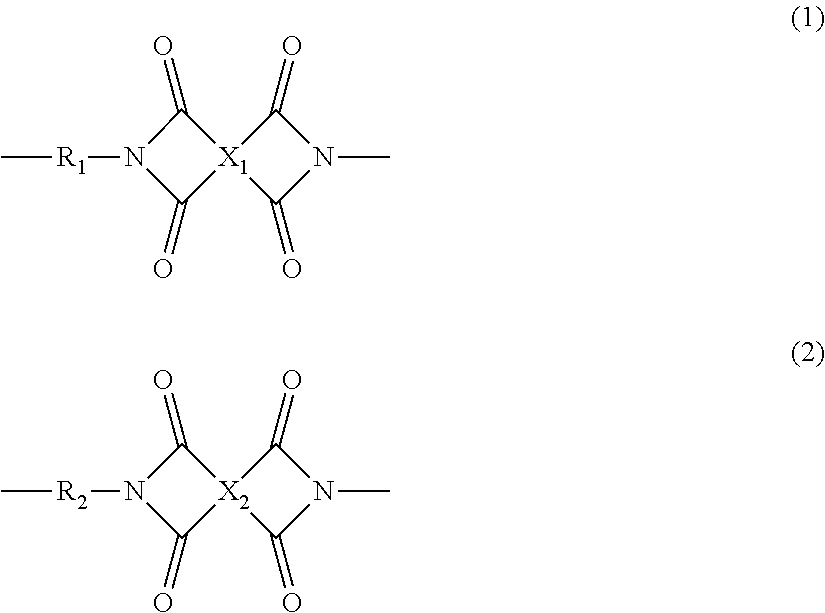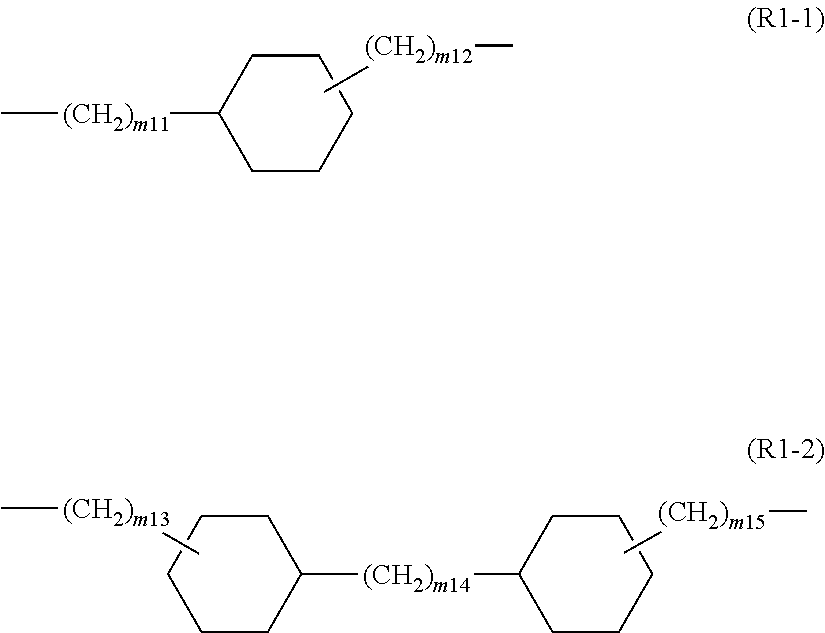Polyimide resin
a polyimide resin and polyimide technology, applied in the field of thermoplastic polyimide resins, can solve the problems of low molding process ability, difficult processing, and lack of thermoplasticity, and achieve the effects of high heat resistance, high mold processability and heat resistance, and good balan
- Summary
- Abstract
- Description
- Claims
- Application Information
AI Technical Summary
Benefits of technology
Problems solved by technology
Method used
Image
Examples
example 1
[Example 1] Production of Polyimide Resin 1
[0234]600 g of 2-(2-methoxyethoxy)ethanol (produced by Nippon Nyukazai Co., Ltd.) and 218.58 g (1.00 mol) of pyromellitic dianhydride (produced by Mitsubishi Gas Chemical Company, Inc.) were introduced in a 2 L separable flask equipped with a Dean-Stark apparatus, a Liebig condenser tube, a thermocouple, and a four-paddle blade. After creation of a nitrogen flow, the mixture was agitated at 150 rpm so as to become a homogeneous suspended solution. On the other hand, 49.42 g (0.347 mol) of 1,3-bis(aminomethyl)cyclohexane (produced by Mitsubishi Gas Chemical Company, Inc.) and 93.16 g (0.645 mol) of 1,8-octamethylenediamine (produced by Kanto Chemical Co., Inc.) were dissolved in 250 g of 2-(2-methoxyethoxy)ethanol with a 500 mL beaker, thereby preparing a mixed diamine solution. This mixed diamine solution was gradually added thereto with a plunger pump. The dropwise addition of the mixed diamine solution was carried out in a nitrogen flow s...
example 2
[Example 2] Production of Polyimide Resin 2
[0238]500 g of 2-(2-methoxyethoxy)ethanol (produced by Nippon Nyukazai Co., Ltd.) and 109.06 g (0.500 mol) of pyromellitic dianhydride (produced by Mitsubishi Gas Chemical Company, Inc.) were introduced in a 2 L separable flask equipped with a Dean-Stark apparatus, a Liebig condenser tube, a thermocouple, and a four-paddle blade. After creation of a nitrogen flow, the mixture was agitated at 150 rpm so as to become a homogeneous suspended solution. On the other hand, 21.18 g (0.149 mol) of 1,3-bis(aminomethyl)cyclohexane (produced by Mitsubishi Gas Chemical Company, Inc.) and 50.12 g (0.347 mol) of 1,8-octamethylenediamine (produced by Kanto Chemical Co., Inc.) were dissolved in 200 g of 2-(2-methoxyethoxy)ethanol with a 500 mL beaker, thereby preparing a mixed diamine solution. This mixed diamine solution was gradually added thereto with a plunger pump. The dropwise addition of the mixed diamine solution was carried out in a nitrogen flow ...
example 3
[Example 3] Production of Polyimide Resin 3
[0240]500 g of 2-(2-methoxyethoxy)ethanol (produced by Nippon Nyukazai Co., Ltd.) and 109.06 g (0.500 mol) of pyromellitic dianhydride (produced by Mitsubishi Gas Chemical Company, Inc.) were introduced in a 2 L separable flask equipped with a Dean-Stark apparatus, a Liebig condenser tube, a thermocouple, and a four-paddle blade. After creation of a nitrogen flow, the mixture was agitated at 150 rpm so as to become a homogeneous suspended solution. On the other hand, 17.65 g (0.124 mol) of 1,3-bis(aminomethyl)cyclohexane (produced by Mitsubishi Gas Chemical Company, Inc.) and 53.70 g (0.372 mol) of 1,8-octamethylenediamine (produced by Kanto Chemical Co., Inc.) were dissolved in 200 g of 2-(2-methoxyethoxy)ethanol with a 500 mL beaker, thereby preparing a mixed diamine solution. This mixed diamine solution was gradually added thereto with a plunger pump. This dropwise addition of the mixed diamine solution was carried out in a nitrogen flow...
PUM
| Property | Measurement | Unit |
|---|---|---|
| thickness | aaaaa | aaaaa |
| temperature | aaaaa | aaaaa |
| Tg | aaaaa | aaaaa |
Abstract
Description
Claims
Application Information
 Login to View More
Login to View More - R&D
- Intellectual Property
- Life Sciences
- Materials
- Tech Scout
- Unparalleled Data Quality
- Higher Quality Content
- 60% Fewer Hallucinations
Browse by: Latest US Patents, China's latest patents, Technical Efficacy Thesaurus, Application Domain, Technology Topic, Popular Technical Reports.
© 2025 PatSnap. All rights reserved.Legal|Privacy policy|Modern Slavery Act Transparency Statement|Sitemap|About US| Contact US: help@patsnap.com



